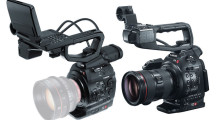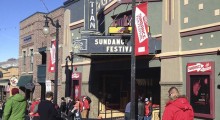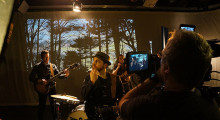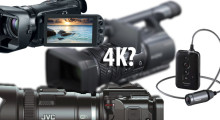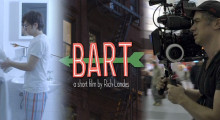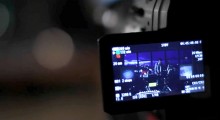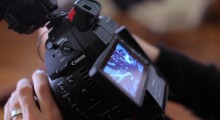Cinematography
Filmmaking - Cinematography
-
Canon C100 or C300: Which One to Get?

For many, the release of the Canon C100 has prompted one question: Which one do I get? Or, in other words, is the C300 really worth $9,500 more than the C100? These cameras have the same sensor and very similar bodies, and Canon even includes C-Log on both, but there are a lot of differences. Perhaps the most notable: C300 records internally 4:2:2 MPEG-2, while the C100 records 4:2:0 AVCHD 60p recording (at 720p) is available on the C300 but not the C100 C300 has HD-SDI & Genlock, C100 just has HDMI C100 is smaller There are other differences: The […]
-
Festival Cinematography Notes – At Sundance, Alexa Rising

The day Sundance began, Daily Variety’s lead article kicked off with: “In this brave new indie world of VOD, shifting release windows, RED cameras [italics mine] and social media marketing…” I was struck by how little any of this has to do with indie filmmaking alone. As a token of digital revolution, RED cameras are so five years ago. It’s hard to storm the ramparts when last year’s #5 and #7 box office hits were shot with RED Epics (The Hobbit: An Unexpected Journey, The Amazing Spider-Man). In fact, not only were last year’s #1 and #4 hits filmed with […]
-
Using a Home Projector for Rear Projection

Rear projection, a technique that involves projecting a background image onto a screen behind your actors, is a technique that was popular in the 40s and 50s, particularly for shooting vehicle interiors. It wasn’t perfect; the image can seem washed out compared to the foreground actors making it easy to spot the technique, and rear projection requires a fairly large studio space. Rear projection has been mostly replaced, first by front projection, and by blue- and green-screen techniques. Even low-budget NLEs now include very good green-screen filters that produce excellent results; though it’s your technique when shooting the footage that […]
-
Seeing RED at Sundance

If you’re shooting a full-length feature, the cost of purchasing, developing and transferring your film to digital can easily be more than the cost of a digital camera. (If your shooting ratio is 4:1, you’d spend over $10,000 for 16mm and $20,000 for 35mm.) And in some cases more than the total budget of your film. It’s no wonder then, that digital cameras have become dominant in indie film production, and that RED, with its head start as an “affordable” digital cinema camera, has become dominant at Sundance. Ted Schilowitz, co-founder of RED Digital Cinema, noted that “there are so […]
-
Getting the Shot: Scenes from the Making of the Music Video, “Ready or Not”

In a previous article (An Afternoon Music Video Shoot with the Canon C300) I documented a day shooting scenes for a new music video for the band Air Traffic Controller. The completed video, as well as a making-of piece have now been posted. Director/DP/Editor Rick Macomber explained that he decided to do this video after seeing Dave Munro from ATC perform the song acoustically. Said Rick “I was listening to the lyrics and I knew how close the song was to Dave’s personal life and it touched me. So when he came to me and asked which song I would […]
-
Shooting the Short BART: an Interview with the Director and DP

When L.A.-based director Rich Landes was offered the chance to shoot a short narrative piece for Canon he jumped at the chance. Landes has extensive experience as a commercial director, but this was a chance to direct a narrative based on his own idea, and with few restrictions from the “client.” But first he had to come up with an idea and treatment in two days. Then he had to fly to New York and cast, find locations, and hire a DP in four days, and then shoot the whole thing over the course of two days. None of this […]
-
4K comes to CES and Canon announces new Cine Primes

The Consumer Electronics Show (CES), which ran January 7-10 in Las Vegas, is not the place to see the latest pro gear, but it is a good place to see the general direction of the electronics entertainment industry. Just a couple of years ago 3D was the rage, with manufacturers showing off their 3D displays and headsets. By all reports, 3D wasn’t so hot this year. Instead, we saw the first salvos in the 4K battle to convince consumers to part with their money for another high-end display. But when it comes to televisions, 2013 may be seen as the […]
-
Behind The Scenes on BART: a Narrative Short Shot with the Canon C100

Recently we published an interview about the making of the short film Pulse, which was financed by Canon and shot on their new C100. Canon subsequently contacted us about a second short, BART, which was also shot on the C100. While Pulse is a documentary piece, BART is a four-minute short that is entirely an exercise in narrative story telling. Canon was specifically looking for a film that had little language and had a lot of visuals to it. BART will premiere next week at a special screening and workshop at the Sundance Film Festival, but today Canon is releasing […]
-
Pulse: Shooting with the Canon C100, Part II

In Part Two of this interview with Patrick Moreau of StillMotion, Moreau discusses the settings used while filming the short film Pulse with the Canon C100, as well as the lenses and audio hardware they used. He also discusses intercutting footage from the Canon C100 with other cameras. See also: Pulse: Shooting with the Canon C100 Part One Filmmaker: For this project you were recording to AVCHD? Moreau: Yes. We used AVCHD in this situation because we wanted it to be as natural as possible, which is possible with this small footprint. We did an AT&T campaign for the Olympics […]
-
Pulse: Shooting with the Canon C100, Part One

When manufacturers are preparing a new camera for release, they often loan pre-production units to filmmakers in the hope that they’ll make a video the company can use to promote the camera. Such is the case with the Canon C100. Canon loaned the filmmakers of StillMotion two C100 bodies and financed the making of a short video, Pulse. As StillMotion described in their blog post on the making of the video, the idea for the video came from a potential client: We’d recently been approached to make a Kickstarter film for a team who had created a pretty remarkable innovation […]
